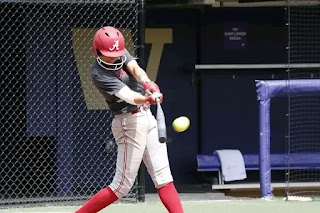11 Tips to Hit the Ball Properly in Softball
Batting is one of the most important skills in softball, and it can make a big difference in how often you get on base and score runs. You may think that hitting the ball hard is all that matters, but there are many small things that can help you master the basics of batting. In this article, we will guide you through each step of the batting process so you can hit the ball with more accuracy and power!
 |
| 11 Tips to Hit the Ball Properly in Softball |
1. Grip
Use a light grip with your fingers to have more control over the bat. When you hold the bat's handle, place your non-dominant hand so it's only 2–3 finger-widths away from the end of the handle. Put your dominant hand right above your non-dominant hand so your second knuckles line up. Don't squeeze the bat too tightly or hold it in your palm, because that will make your forearms stiff and reduce your swing speed.
- To find the right grip, you can rest the bat on your shoulder and let your elbows relax.
- Don't hold the bat too high on the handle, because that will decrease your swing power.
2. Stance
Stand facing the plate so you can reach pitches on both sides. Step into the batter's box next to the plate so your non-dominant shoulder faces the pitcher. Spread your feet out a little bit wider than your hips so your toes are parallel to the plate. Distribute your weight evenly on the balls of your feet. Slightly bend your knees and ankles to be ready to swing. Keep your spine straight, but lean forward slightly at the hips so you're over home plate.
- Stretch your bat across home plate and check if you can touch the opposite corner. If you can't reach it easily, move closer to the plate until you can.
- You can adjust your feet slightly wider or narrower depending on what feels most comfortable for you.
- While most coaches suggest starting with a square stance, you can also move your front foot away from the plate to open up and see the ball better. You can also use a closed stance with your front foot near the plate. It depends on what you like and what works best for you.
3. Bat position
Keep your elbows low and your arms bent as you get ready to swing. Put the bat on your back shoulder and let your elbows relax so you don't have any tension. Try to form a triangle or an A-shape with your forearms to make sure you're holding the bat correctly. Then, raise your arms straight up until your hands are at ear-level and your front elbow forms a right angle. Then, angle your bat up so it's 45 degrees from the ground. Make sure to keep your front shoulder loose and pointed toward the pitcher.
- Don't lift your back elbow higher than your front elbow, because that will make you lose balance while swinging.
4. Head position
Look straight at the pitcher so you can track the ball better. Turn your head toward the pitcher so you can see them with both eyes. Don't look away from the pitcher to check your grip or the bases, but focus on the pitcher so you can get ready for the ball. That way, it's easier to follow the ball and anticipate where it will go in the strike zone.
5. Load
Move your weight to your back foot as the pitcher throws the ball. As soon as the pitcher completes their wind-up and releases the ball, shift all of your weight to your back leg, because that's where most of your power comes from. Keep your back foot planted on the ground and bend your knee slightly more to generate more force from your swing.
- Don't swing the bat yet. Since you're moving your weight backward, trying to move the bat forward will make you feel unstable.
6. Stride
Move your front foot forward to increase your swing speed. As you transfer your weight to your back foot, raise your front foot slightly off the ground. Then, put the ball of your front foot back on the ground so your toes point a little bit forward. Some people barely lift their toes off the ground while others take a bigger step forward. It depends on what feels most comfortable for you, so experiment with different swings to see what suits you.
- This is also known as a “toe tap.”
- This action helps you gain forward momentum so you can swing faster and get more power from your hit.
7. Swing
Start your swing with your hands so the bat moves forward faster. Lift your back heel and turn your foot so the toes point forward during your swing. Rotate your hips toward the ball to get more power. Aim your front elbow toward the pitcher and swing your arms over home plate until the bat faces the catcher. At this point, your dominant hand, elbow, and back thigh will be aligned.
- Keep your head still while you’re swinging. If you look up or away from where you’re swinging, then you may miss or not hit the ball well.
- Lowering your back shoulder so it’s below your front shoulder can make it easier to swing.
8. Contact
Hit the ball so your bat is level with your shoulder. Try to hit the ball just in front of home plate so the direction of your swing is level with the top of your shoulders. Keep a slight bend in your elbows so your arms are not fully stretched, or else you won’t get as much power from your hit.
9. Extension
Keep your hands in front of the bat, or else you’ll hit the pitch wide and not have as much control.
Point the bat toward the pitcher to extend contact with the ball. Your ball will go further the longer you touch the bat with it. Completely straighten your arms and quickly twist your wrists in the direction of your swing so the bat snaps forward and faces the pitcher. If you keep your arms fully stretched, you’ll probably hit ground balls or not hit the ball well.
10. Follow-through
Swing the bat up behind your head to put more power in your swing. Don't stop putting force into your swing when you touch the ball. Instead, bring your arms across the front of your body and swing the bat behind you. Try to avoid hitting your back with your bat since it could lead to a weaker hit.
- Some players release the bat with their back hand at the end of the follow-through. It all depends on what feels best for you.
- Finish your swing, extension, and follow-through all in one smooth motion to make sure you hit the ball as far and hard as you can.
11. Strike zone
Only swing at balls that go over home plate within the zone. In fast-pitch softball, the strike zone is the area right over home plate between your armpits and the top of your knees. If you play slow-pitch, then the strike zone is still right over home plate, but in the area between the top of your back shoulder and your front knee. Don't swing at any pitch thrown outside the strike zone since it’ll be a ball.
- The size of the strike zone may change slightly depending on the umpire calling the game. Watch what they’ve called balls and strikes so you can get an idea of where the zone is.
Frequently Asked Questions
How do you avoid striking out in softball?
Be alert when you're at bat. If the pitcher got you out before with a specific pitch, be ready for that same pitch again.
What do I do when someone hits the ball in the air?
If the ball is in the air, stay near your base. If it's hit to the outfield and it looks like it will be caught, move half-way to the next base and watch if it's caught. If it is, go back to your base. If it's not, keep going to the next base or further. If the ball is hit far, go back to your base right away and touch it if you think you can safely go to the next base. Your coach should be guiding you during this time to help you make a decision.





